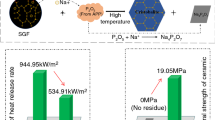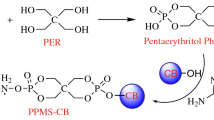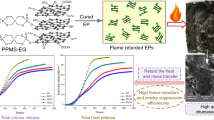Abstract
The development of ceramifiable polymer composites is an important means to ensure public safety and meet the emergency operation of power supply lines of public facilities in case of fire. Although there have been many researches on ceramifiable flame-retardant polymer composites and published scientific research achievements, the problem of poor flame-retardant effect of ceramifiable polymer materials due to low flame-retardant efficiency has not been solved. In this study, ethylene–vinyl acetate copolymer (EVA) was used as the matrix, E-glass fiber (EGF) and low softening point glass powder (GP) were selected as the ceramifiable filler (CF), and melamine (MA) and organic modified montmorillonite (OMMT) were used as the complex flame-retardant system. The flame-retardant test results show that when the composition of the composite is EVA/CF (GP:EGF)/MA/OMMT = 35/32 (7:3)/28/5, the flame-retardant property reaches V-0 rating (UL-94), and the corresponding LOI is 27.8. At this time, the bending strength of EVA composite-based ceramic fired at 700 °C reaches 5.1 MPa. TG-IR test results confirmed that a large amount of nonflammable gases from melamine thermal decomposition diluted the combustible gases produced by EVA decomposition, which is the reason why EVA composite has good flame retardancy.









Similar content being viewed by others
References
Li YM, Deng C, Zhao ZY, et al. Carbon fiber-based polymer composite via ceramization toward excellent electromagnetic interference shielding performance and high temperature resistance. Compos A Appl Sci Manuf. 2020. https://doi.org/10.1016/j.compositesa.2020.105769.
Yang J, Xu Y, Jiang W, et al. The thermal transformation process and mechanical strength evolution of ceramifiable silicone composites. Ceram Int. 2021. https://doi.org/10.1016/J.CERAMINT.2021.04.134.
Song J, Huang Z, Qin Y, et al. Effects of zirconium silicide on the vulcanization, mechanical and ablation resistance properties of ceramifiable silicone rubber composites. Polymers. 2020. https://doi.org/10.3390/polym12020496.
Guo J, Gao W, Wang Y, et al. Effect of glass frit with low softening temperature on the properties, microstructure and formation mechanism of polysiloxane elastomer-based ceramizable composites. Polym Degrad Stab. 2017. https://doi.org/10.1016/j.polymdegradstab.2016.12.012.
Guo J, Zhang Y, Li H, et al. Effect of the sintering temperature on the microstructure, properties and formation mechanism of ceramic materials obtained from polysiloxane elastomer-based ceramizable composites. J Alloy Compd. 2016. https://doi.org/10.1016/j.jallcom.2016.04.030.
Hu S, Chen F, Li JG, et al. The ceramifying process and mechanical properties of silicone rubber/ammonium polyphosphate/aluminium hydroxide/mica composites. Polym Degrad Stab. 2016. https://doi.org/10.1016/j.polymdegradstab.2016.02.010.
Imiela M, Anyszka R, Bieliński DM, et al. Effect of carbon fibers on thermal properties and mechanical strength of ceramizable composites based on silicone rubber. J Therm Anal Calorim. 2016. https://doi.org/10.1007/s10973-015-5115-x.
Anyszka R, Bieliński DM, Pędzich Z, et al. Effect of mineral filler additives on flammability, processing and use of silicone-based ceramifiable composites. Polym Bull. 2018. https://doi.org/10.1007/s00289-017-2113-0.
Lou F, Wu K, Wang Q, et al. Improved flame-retardant and ceramifiable properties of EVA composites by combination of ammonium polyphosphate and aluminum hydroxide. Polymers. 2019. https://doi.org/10.3390/polym11010125.
Zhao D, Shen Y, Wang T. Ceramifiable EVA/APP/SGF composites for improved ceramifiable properties. Polym Degrad Stab. 2018. https://doi.org/10.1016/j.polymdegradstab.2018.02.006.
Li YM, Deng C, Long JW, et al. Improving fire retardancy of ceramifiable polyolefin system via a hybrid of zinc borate@ melamine cyanurate. Polym Degrad Stab. 2018. https://doi.org/10.1016/j.polymdegradstab.2018.05.012.
Price D, Liu Y, Milnes GJ, et al. An investigation into the mechanism of flame retardancy and smoke suppression by melamine in flexible polyurethane foam. Fire Mater. 2002. https://doi.org/10.1002/fam.810.
Zhou R, Mu J, Sun X, et al. Application of intumescent flame retardant containing aluminum diethyphosphinate, neopentyl glycol, and melamine for polyethylene. Saf Sci. 2020. https://doi.org/10.1016/j.ssci.2020.104849.
Xu W, Wang G, Xu J, et al. Modification of diatomite with melamine coated zeolitic imidazolate framework-8 as an effective flame retardant to enhance flame retardancy and smoke suppression of rigid polyurethane foam. J Hazard Mater. 2019. https://doi.org/10.1016/j.jhazmat.2019.120819.
Zhang Z, Du J, Shi M. Quantitative analysis of the calcium hydroxide content of EVA-modified cement paste based on TG-DSC in a dual atmosphere. Materials. 2022. https://doi.org/10.3390/MA15072660.
Qian Y, Li S, Chen X. Preparation of mesoporous silica-LDHs system and its coordinated flame-retardant effect on EVA. J Therm Anal Calorim. 2017. https://doi.org/10.1007/s10973-017-6508-9.
Hu X, Li M, Yang J, et al. In situ fabrication of melamine hydroxy ethylidene diphosphonate wrapped montmorillonite for reducing the fire hazards of epoxy resin. Appl Clay Sci. 2021. https://doi.org/10.1016/J.CLAY.2020.105934.
Yang W, Song L, Hu Y, Lu H, Yuen RKK. Investigations of thermal degradation behavior and fire performance of halogen-free flame retardant poly(1,4-butylene terephthalate) composites. J Appl Polym Sci. 2011. https://doi.org/10.1002/app.34119.
Wang Y, Yuan J, Ma L, Yin X, Zhu Z, Song P. Fabrication of anti-dripping and flame-retardant polylactide modified with chitosan derivative/aluminum hypophosphite. Carbohyd Polym. 2022. https://doi.org/10.1016/J.CARBPOL.2022.120141.
Chen X, Huo L, Jiao C, et al. TG–FTIR characterization of volatile compounds from flame retardant polyurethane foams materials. J Anal Appl Pyrol. 2013. https://doi.org/10.1016/j.jaap.2012.12.017.
Guo Y, Liu J, Luo J, et al. Enhancement of thermal stability and flame retardancy of ethylene vinyl acetate/magnesium hydroxide composite by carbon black. Fire Mater. 2022. https://doi.org/10.1002/fam.3093.
Cong X, Sun X, Ning B. Could infrared spectroscopy identify melamine-related stone using melamine-contained mixture as a reference? J Clin Lab Anal. 2013. https://doi.org/10.1002/jcla.21562.
Mircescu NE, Oltean M, Chiş V, et al. FTIR, FT-Raman, SERS and DFT study on melamine. Vib Spectrosc. 2012. https://doi.org/10.1016/j.vibspec.2012.04.008.
Jia C, Chen X, Qian Y. Synergistic flame retardant effect of graphite powder in EVA/LDH composites. Plast, Rubber Compos. 2014. https://doi.org/10.1179/1743289813Y.0000000072.
Yang W, Song L, Hu Y, et al. Enhancement of fire retardancy performance of glass-fibre reinforced poly (ethylene terephthalate) composites with the incorporation of aluminum hypophosphite and melamine cyanurate. Compos B Eng. 2011. https://doi.org/10.1016/j.compositesb.2011.03.019.
Li L, Qian Y, Jiao CM. Synergistic flame retardant effect of melamine in ethylene–vinyl acetate/layered double hydroxides composites. J Therm Anal Calorim. 2013. https://doi.org/10.1002/pen.23619.
Chen X, Ma C, Jiao C. Synergistic effects between iron–graphene and melamine salt of pentaerythritol phosphate on flame retardant thermoplastic polyurethane. Polym Adv Technol. 2016. https://doi.org/10.1002/pat.3823.
Yang W, Lu H, Tai Q, et al. Flame retardancy mechanisms of poly (1, 4-butylene terephthalate) containing microencapsulated ammonium polyphosphate and melamine cyanurate. Polym Adv Technol. 2011. https://doi.org/10.1002/pat.1735.
Hu JP, Li D, Qin Y, et al. Promotion effect of melamine on flame retardancy of epoxy resins containing caged bicyclic phosphate. Chin J Polym Sci. 2007. https://doi.org/10.1142/s0256767907002497.
Jiang Y, Zhou W, Jiang M, et al. Flame retardant study of formalized polyvinyl alcohol fiber coated with melamine formaldehyde resins and the synergistic effect of copper ions. Polym Degrad Stab. 2017;144:331–43. https://doi.org/10.1016/j.polymdegradstab.2017.08.014.
Xu D, Yu K, Qian K. Thermal degradation study of rigid polyurethane foams containing tris (1-chloro-2-propyl) phosphate and modified aramid fiber. Polym Test. 2018;67:159–68. https://doi.org/10.1016/j.polymertesting.2018.01.034.
Funding
The funding was provided by Science and Technology Support Plan Project of Ningxia, China, NKJZ [2015] No. 26 Document, The First-rate Discipline (Education) Construction Project of the Higher Education Institutions of Ningxia, China, No. NXYLXK2017B11, Engineering and Technology Research Center of Liupanshan Resources Grant, and Ningxia Normal University, China, No. HGZD19-03, and Natural Science Foundation of Ningxia, China, 2020AAC03261.
Author information
Authors and Affiliations
Corresponding author
Additional information
Publisher's Note
Springer Nature remains neutral with regard to jurisdictional claims in published maps and institutional affiliations.
Rights and permissions
Springer Nature or its licensor (e.g. a society or other partner) holds exclusive rights to this article under a publishing agreement with the author(s) or other rightsholder(s); author self-archiving of the accepted manuscript version of this article is solely governed by the terms of such publishing agreement and applicable law.
About this article
Cite this article
Di, HW., Fan, C., He, H. et al. A novel EVA-based composite via ceramization toward excellent flame retardance performance and high-temperature resistance. J Therm Anal Calorim 148, 11717–11726 (2023). https://doi.org/10.1007/s10973-023-12524-3
Received:
Accepted:
Published:
Issue Date:
DOI: https://doi.org/10.1007/s10973-023-12524-3




